Text
Harvard Referencing
April Towriess (2020). Textile Artists Inspired by Nature. [online] Community Fibre Artist and Crochet Designer | Nottingham | 14+ Years Experience | Pattern Design | Crochet Lessons | Community Projects |. Available at: https://www.apriltowriess.co.uk/blog/top-10-textile-artists-inspired-by-nature.
Behal, A. (2020). The Green Revolution and a dark Punjab. [online] www.downtoearth.org.in. Available at: https://www.downtoearth.org.in/blog/agriculture/the-green-revolution-and-a-dark-punjab-72318#:~:text=While%20the%20Green%20Revolution%20provided [Accessed 24 May 2022].
Drennan, G. (2021). 7 Tips to Write a Great Blog Post Introduction. [online] Content Marketing Institute. Available at: https://contentmarketinginstitute.com/2021/06/tips-write-blog-post-introduction/ [Accessed 25 Mar. 2022].
G3Fashion (2016). History that we know of Salwar Kameez. [online] G3+ Fashion. Available at: https://g3fashion.com/blog/fashion/history-of-salwar-kameez/.
Heather (2016). Valentino Fall 2016 at Paris Fashion Week. [online] Go Fug Yourself. Available at: https://www.gofugyourself.com/photos/paris-fashion-week-valentino-fall-2016/gettyimages-514335196_master [Accessed 24 May 2022].
IndianExpressOnline (2020). Quixplained: What are the Farm Reform Bills | Farm Bill Explained. [online] www.youtube.com. Available at: https://www.youtube.com/watch?v=4XeTInELA_k&ab_channel=IndianExpressOnline [Accessed 11 Apr. 2022].
Investpunjab (2020). Textile Sector of Punjab, India. [online] investpunjab.gov. Available at: http://investpunjab.gov.in/assets/docs/japan_textile_english.pdf.
Jasjot Singh Hans (n.d.). FASHION. [online] Jasjyot Singh Hans. Available at: https://www.jasjyotjasjyot.com/fashion [Accessed 22 Mar. 2022].
Kisaanekta.co (n.d.). Timeline: Agriculture in Punjab. [online] Kisaan Ekta Co. Available at: https://www.kisaanekta.co/punjabfarming-timeline [Accessed 20 Apr. 2022].
Li, C. (2020). The Ultimate Guide to Necklines. [online] Petite Dressing. Available at: https://blog.petitedressing.com/necklines/#Asymmetric_Neckline [Accessed 24 May 2022].
MerriamWebster (2022). Definition of KISAN. [online] www.merriam-webster.com. Available at: https://www.merriam-webster.com/dictionary/kisan#:~:text=Definition%20of%20kisan [Accessed 8 May 2022].
Nast, C. (n.d.). Dsquared2 Spring 2019 Menswear Fashion Show. [online] Vogue. Available at: https://www.vogue.com/fashion-shows/spring-2019-menswear/dsquared/slideshow/collection#1 [Accessed 24 May 2022].
Pinterest (n.d.). Pinterest. [online] Pinterest. Available at: https://www.pinterest.co.uk/search/pins/?q=final%20garment%20illustration&rs=typed&term_meta.
Roman, S. (2018). sculpture 1 — Sommer Roman. [online] Sommer Roman. Available at: https://www.sommerroman.com/sculpture.
sheyyin (2015). Sewing. [online] S.Yin Lee. Available at: https://sheyyinlee.wordpress.com/category/sewing/ [Accessed 23 May 2022].
SONTHALIA, K. and BHOWMICK, N. (2021). The Women at the Frontlines of India’s Farmers’ Protests. [online] Time. Available at: https://time.com/5942125/women-india-farmers-protests/.
Statista Research Department (2022). India: wheat production in Punjab 2020. [online] Statista. Available at: https://www.statista.com/statistics/1019549/wheat-production-in-punjab-india/#:~:text=In%20financial%20year%202020%2C%20over [Accessed 24 May 2022].
Utah State University, Shirley, L. and Roueche, J. (n.d.). DESIGN Elements of Design. [online] Available at: https://digitalcommons.usu.edu/cgi/viewcontent.cgi?article=2503&context=extension_curall.
0 notes
Text
Evaluation of KISAAN + Foundation Year
Throughout this project I have learnt so many different skills and have progressed with a huge amount of growth over this past academic year. Form understanding how to research extensively to participating in printing workshops, there are a number of reflections to analyse about this project.
Whilst I was researching about the farmers protest, my first initial thought was how I would be able to translate this idea into a garment. One of the most important things about this project was to show my skills and abilities to then professionally be able to have the knowledge to move onto BA Fashion Design at BCU. I started off by writing and creating as many ideas as I could through a range of mind maps in my journal, as well as sketches when I would come up with ideas. This then led me to think about the process of researching context for my blog. After extensive research about farming in Punjab, I finally felt more confident about this project. My confidence during the start of this project was slightly shaky, however after discussing my project brief and presentation, I felt certain that I would try my hardest to complete this project to the best of my ability.
These subtitles are sections about the context of my project:
Farmers Protest 2020
History of farming in Punjab
Fashion Illustrations
Punjab’s Fashion Past vs Present
Wheat Fact
This is crucial as it is a part of understanding different aspects of my development and the growth of my samples and my final garment.
After researching aspects of the farmers protest, I then moved on to what I wanted to focus my samples on. I then began to take part in workshops directed by the technicians in the print room and embroidery.
I created samples based on crops that are predominantly grown in Punjab, such as wheat and sugar canes. The reasons for this research is due to its popularity in Punjab, as many farmers are reliant upon growing and selling these particular crops.
The first sample I created involved a method called honeycomb tucks. I was unaware of this method before completing my sample, however after some research I was very pleased with the colours and the extent to which my imagination and creativity was pushed. Some illustrations were also created as part of the design aspect of this project which initialised the thoughts and ideas of my final garment.
Whilst creating these samples, I reflected upon the elements of design pdf when I was researching for my context. I understood the shape, line, and design elements whilst creating these illustrations. However, I felt as though I could have used my fashion illustration research at the start of this project to gain some inspiration on how to successfully draw a fashion illustration. I felt as though I added little to no detail of the honeycomb tucks in my drawing.
The next sample involved braids. I developed these samples extensively through using different types of mixed media and sewing techniques. After looking at the presentations provided by my tutors and feedback in tutorials by Paula, Louise, and Natalie, I was confident in the creation of my samples. The use of the braids have demonstrated confidence and stability as they have translated through the journey towards my final garment. I would like to comment that I wish I printed onto my fabrics to further extend my development of these samples. I would also like to add more visuals in my sketchbook of step by step processes on how I created these samples to provide a process.
I then illustrated a number of designs, all of which were different and unique, while still translating the topic of farming. The warm and rich colours and exciting contrasting of braids enhance up each garment design. I also extracted inspiration from my fashion illustration research and successfully created more professional and detailed illustrations to a higher standard.
After these illustrations, I created a mood board and used a quote about wheat to complete the topic of wheat within my project. I feel as though this really finished off the topic and allowed a transition to the next element of my project.
Whilst I was still researching crops, I wanted to look further into sugar canes and its development as an idea. This is when I created 4 samples based on the manipulation of sugar canes through textiles. I was very pleased with the outcome however I hoped to further extend my ideas, if given more time.
The embellishment of my samples related back to the vast embroidery and embellishment on Punjabi garments as these patterns are considered beautiful, I wanted to follow that trend to portray the beauty of agriculture. I then researched a textiles designer Sommar Roman. I created 2 samples based on her work and this expanded my horizons of how I wanted to imitate sugar canes in my project. This became time consuming as I had limited time during this stage of my project, as final garment ideas were coming into place. If I was to have better time management, I would have been able to grow these samples by adding prints and weaving to my fabrics. I then rounded up this topic of sugar canes by demonstrating some illustrations to stem more ideas towards my final garment.
I also added a range of primary photos into my sketchbook to show the culture and landscapes of Punjab. These primary photographs were captured across my village and I feel as though they contrasted well with my secondary sources. With 2 weeks left of the deadline I then began developing ideas on my final garment. I then researched about my final garment through the use of Pinterest to understand different sketches and how I would go about drawing my final illustrations for the creation of this garment. I wanted to include braids as I felt confident about this sample, and fell as though a range of skills such as confidence and resilience. My patience throughout this project has fluctuated, on the other hand, towards the end of my project I have carefully dedicated enough time to my blog, sketchbook, but especially into my garment.
The creation of my garment was a difficult process as I needed to recreate the structure of the garment, which was the dress, as my fabric choice was wrong and unreliable. I then quickly rectified my mistakes, and with the help of Paula, was able to create my dress with a more suitable fabric. The process of hand sewing the braids carefully took 3 days to complete. Followed by this, finishing touches were needed to ensure my garment was made to a high standard.
Throughout this whole project and this foundation year, there has been a great growth opportunity and have learnt different processes, such as learning the foundations of creating a garment, to initialising one broad idea into many concepts and imaginations, and ultimately into fully completed designs.
0 notes
Text
Final Garment Photographs
The beads on the plats were put on and the fringing was the last thing to do to complete my garment. I think that the over garment shows a great amount of effort, and dedicated time. There is a burst of colours of yellow, gold, tan and brown in this garment. Little details such as the beads and the gold thread and touches of the fringing really make this garment. The design illustrations translated perfectly on my garment and everything I planned and worked towards including my samples were satisfactory.



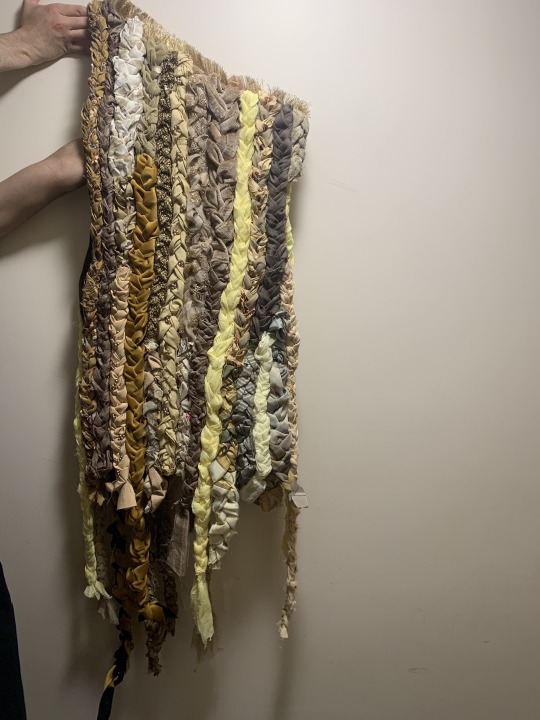
0 notes
Text
Garment finishing - textiles
After sewing all the braids onto the basic shape of the garment, I decided to cut all of the fraying pieces form each braid to neaten up my garment. I then moved onto creating the dangling beads from the sugar cane illustrations as I thought this would finish off the trail of braids on the dress. I also took pictures of any loose braids which needed sewing as some last finishing touches.

The beads on the plats were put on and the fringing was the last thing to do to complete my garment. I think that the over garment shows a great amount of effort, and dedicated time. There is a burst of colours of yellow, gold, tan and brown in this garment. Little details such as the beads and the gold thread and touches of the fringing really make this garment. The design illustrations translated perfectly on my garment and everything I planned and worked towards including my samples were satisfactory.
0 notes
Text
Braids and Garment construction
After the garment was complete I could then move onto sewing the braids onto the garden therefore I carefully planned out the amount of braids that were needed to fill the whole garment. I also needed to calculate the variety of colours and textures of braids that I wanted to include into my garment. The length and size of each braid was also very important to consider.
0 notes
Text
Garment construction
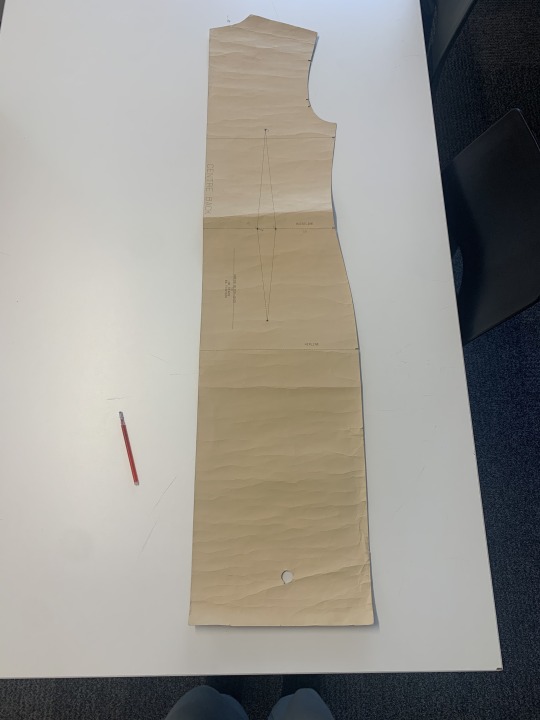
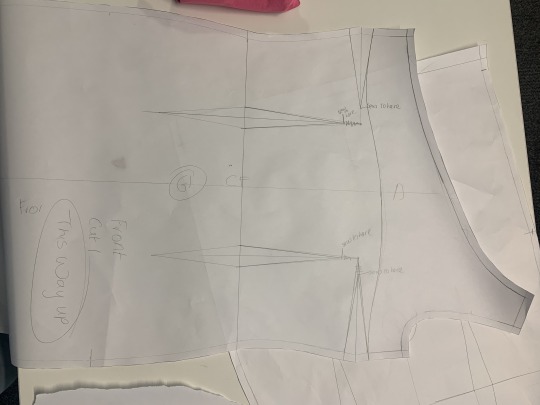

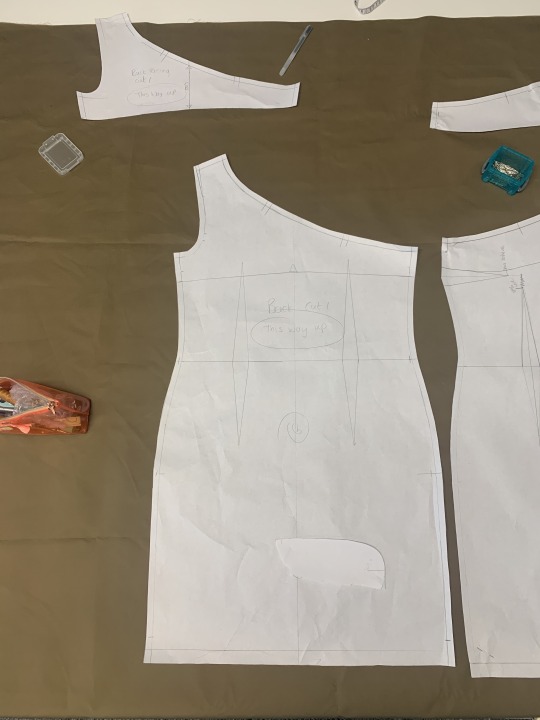


I then went and created the basic dress and correct patterns for the front and back with guidance of Paula. I sewed the darts and pleats of the front and then Paula helped with the zip and the facing. This time my facing pieces was the right size in relation to my pattern cutting stencil. The facing last time was too small and the hand stitching was detectable. The facing on this garment was a lot more professional and neater. Overall the creation of the garment was simple and effective.
0 notes
Text
Garment recreation and feedback
Paula, Lousie and Natalie took a careful look at the creation of my garment and gave some constructive feedback. The main problem with my base layer for the garment was the issue of strength. This was crucial as the fabric would pull down depending on the amount of braid I wanted to attach to the garment. Paula then told me to pin all the braids I had currently made to see if the fabric would hold the weight and they failed to hold all of the braids. The neckline was dragging down to the bust area which was not a good sign. I then needed to recreate the base layer of the dress as this fabric was not liable.

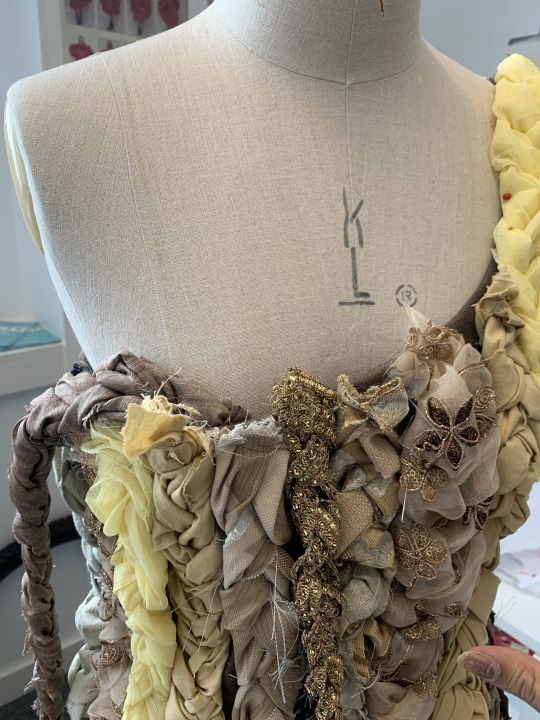
Paula suggested to buy a thicker cotton drill fabric as this would hold my braids much better due to the weight of the garment as a whole. I was also thinking about time and how long this would take to purchase the fabric and to then creating it.
I had two weeks prior to the deadline of creating this garment therefore I got cracking straight away. I bought my fabric and changed the colour of the fabric I was originally using as I wanted a darker base.
0 notes
Text
Step six: garment finishes
I sewed all my facing pieces and pressed these pieces down. After these pieces were complete I then moves onto the the body of the dress. The rest of the dress was complete apart from the finishing touches of the facing which needed some hand stitching. I then continued to hand stitch the edging when I received some feedback in regards to the strength of my fabric.

0 notes
Text
Step five: zip attachment
I also wanted to learn how to sew an invisible zip onto the side of the dress, under the arm of the left of the dress. I used a different footer on the sewing machine and carefully sewed a straight like as close to the zip line as I could. The line was not completely straight therefore I unpicked each stitch. After some practice I finally sewed a straight line. I then pressed my seam down.
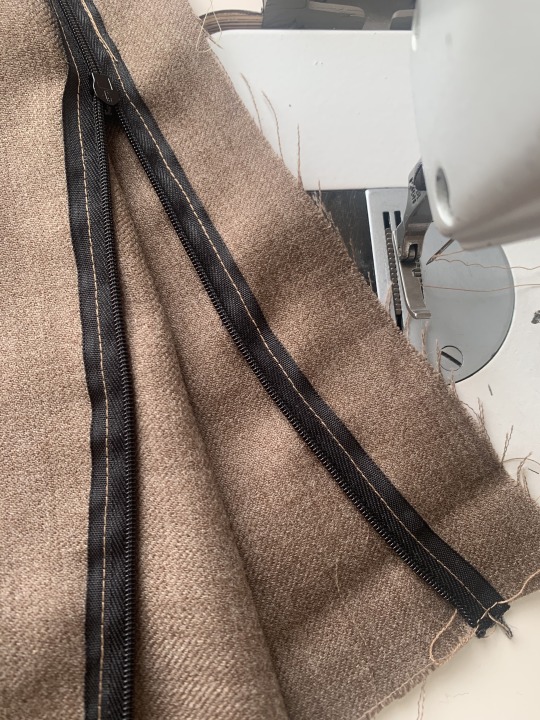


0 notes
Text
Step four: facing pieces
After cutting out the pattern, I also cut out separate facing pieces for the front and back of the dress and the arm holes. Before cutting these strips out I was unaware of the size and made this quite small. However, whilst sewing the facing pieces onto the front and back, the overall look turned out fine.


0 notes
Text
Step two + three: garment fabric and pattern cutting
I then moved onto the creation of the dress in the fabric of what men would wear whilst farming. I wanted to use this fabric as it relates back to the farmers protest and create links back to my project brief and vision.


I cut out my material and measured the shoulder, hip, arm hole, bust and neckline length. After measuring this, I created a brief pattern for the neckline of the dress as the rest of the dress was simple.

0 notes
Text
Step one: collage + illustrations
I started off by creating a collage with inspiration from the collage presentation and drew a few sketches of braids on the page. I used all the fabrics I wanted to use for my braids however I was unsure on whether to create a long garment or a dress.

Due to my time management, I was not able to create a skirt and top therefore I decided to create a mid knee length asymmetric dress as a base for my braids. I then went onto creating a Cad style design for the basic understanding of the dress. I also wanted to add a zip on the side of the dress as appose to the back of the dress for a seamless look.

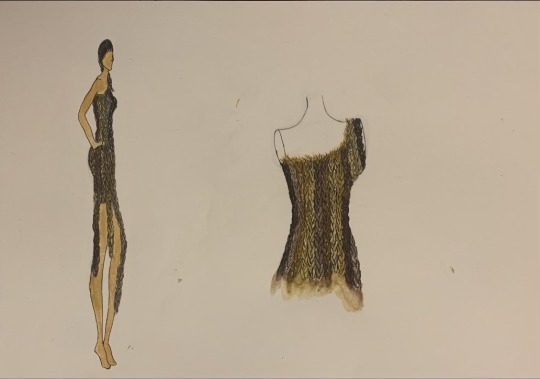
I drew out some illustrations to figure out what I wanted to create. I felt as thought I could combine all my ideas and cover my whole garment in braids. Originally I wanted to cover different types of braids on the front of the garment. The back of the garment was left quite empty therefore I got the opinion of some other students in the room and they all said to create the broads on the back of the garment. I also wanted to provide a close up of the garment in detail show what I wanted to do to finish off the neckline. I wanted to use some gold fringing on the garment to cover any harsh edging and neaten up the overall appearance of the garment.
0 notes
Text
Final garment research
I researched different sketchbooks and how other designers end their sketchbooks whilst being able to show all different types of development, imagery and illustrations. Swatches of fabrics are also important as they help visualise the different textures of what echo fabric will look like. The aim is to break down each process of the garment. From the tailoring of size to the very small details of the garment.
I found a few secondary sources from Pinterest to infuse my thought process of how I would like to present each of my findings and development of what my final garment design entails Pinterest (n.d.).
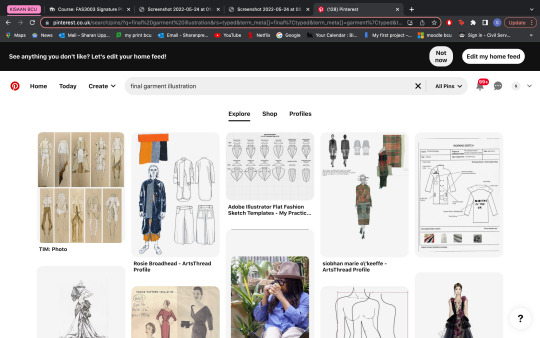
0 notes
Text
Evaluation of samples

Each sample has demonstrated ways in which I could manipulate crops including wheat and sugarcanes. The wheat samples were very successful including my favourite out of the samples which was the braids. I developed them with a range of different techniques to figure out what I liked the most. The beads and the gold paint on the braid added a great sense of texture and brightness towards the whole sample.
The sugar cane samples focused more on textiles. The embellished fabric looked very nice alongside the sample created with inspirations from Sommar Roman. The combination of the two samples also complimented well with each other as the mix of green and beige fabrics looked well with the different beads I used.

Overall I feel as though my samples have translated my topic of crops well however, there are a few things I would like to comment on in terms of my progression in the future. I feel as though I would like to focus on all aspects of my project brief by breaking down this project even more. Crops was one of the topics I decided to go with at first, however given I had more time to complete this whole project I could have delved into the political aspect of this and research more about political designers as the main influence of my project is the farmers protest. I also feel as though I could have developed my first samples more to make professional illustrations like the braided sample designs.
0 notes
Text
Sugar cane Illustration designs
I then chose to create three illustrations for the sugar cane samples and infuse my previous samples to portray a link between the pages. I wanted to experiment with different garments from the last illustrations I created and mix and match my favourite designs to create new and interesting designs.
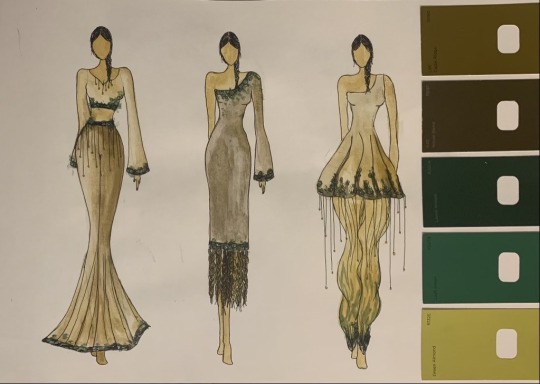
My favourite out of the three would be the Indian style garment with the dress as the top and the salwar trousers. I feel as though adding the beads had a really interesting effect on the garment. I think this finishes of the whole garment very well. I fell as though adding gold would also look very pleasing. I used my sugar cane samples as a border to imitate the traditional Indian suits as they all tend to have a thick golden border on the end on the dress part of the garment to finish off the whole suit. I was not particularly keen on the idea of meshing green and tones of brown and tan together as I I felt as though the colours looked a bit odd against one another. To change this I would add yellow or change the whole colour of the garment itself.
0 notes
Text
Sugar cane sample 2
The second sugar cane sample explores a different aspect of textiles, with fabrics. After researching a few textile artists and came across Sommar Roman, I felt very confident in creating a sample based on her work. I created different ruffles and gathered strips of fabrics to create the edges and pleats. I also imitated the round stuffed circle shape and created a square shape to also imitate the sugar cane shape. To change this, I could develop this sample as make it bigger whilst adding different sequins.
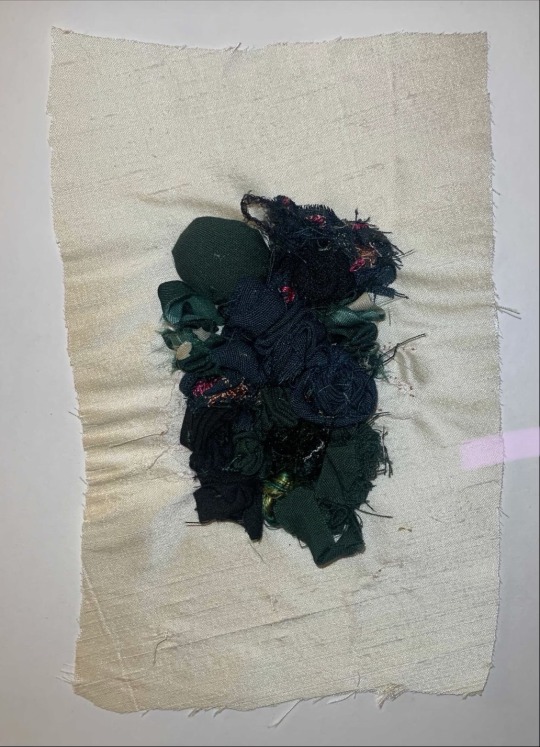
I developed this sample by adding wadding onto a long strip of fabric. I then sewed a green line around the wadding and fabric to then create the square shape of a sugar cane. After figuring how I can develop this I decided to add sequins onto the sample to add more detail and colour to contrast the black fabric.
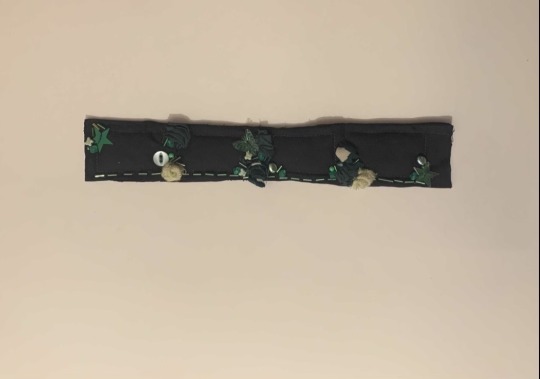
0 notes
Text
Sommar Roman
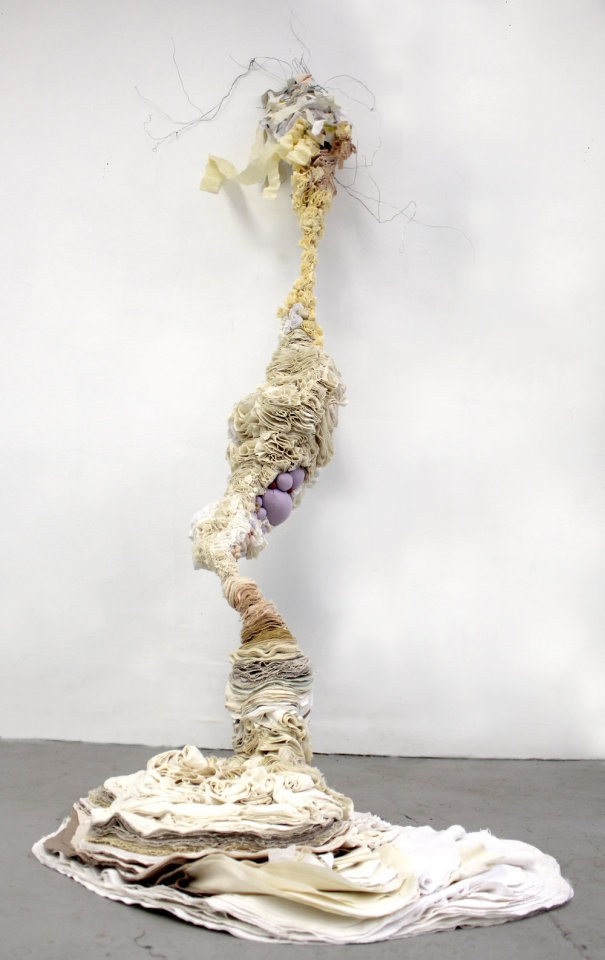

Sommar Roman is a textile artist artist which explores sculptures, illustrations and cell portraits. She dives into different parts of nature and animals in her textile work. The intricate folding and scrunching of the fabric in different colours and shapes create a flow of patterns and visible texture. I have decided to extract influence from Roman due to the emphasis on texture. The folds create secret holes for shadows and darkness allowing the combination of light through the colours of the fabrics and shadow where light cannot reflect through Roman, S. (2018).
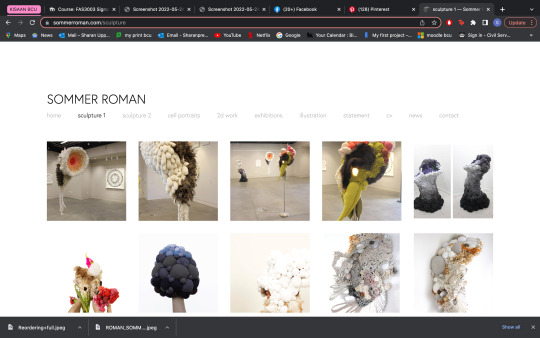
As this foundation course explores textiles and fashion I have noticed the amount of textiles infused in design and the construction of garments. Every garment must have a certain print or embellishment, pattern shape, line and texture. Embellishing a garment is part of the design process and adds an artistic flare to a garment April Towriess (2020).
0 notes